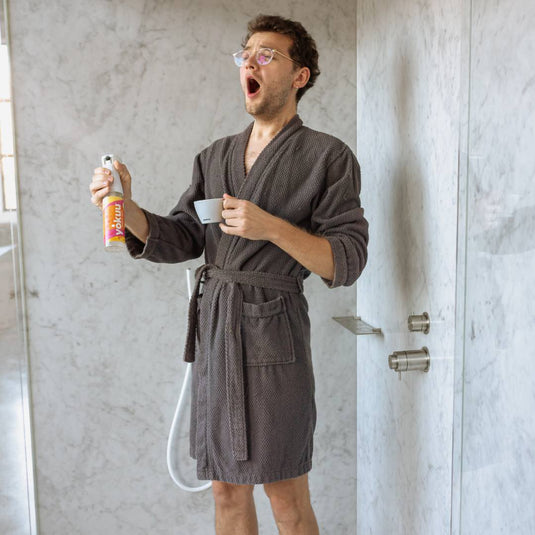
Meet the bacteria that produces the colour pink.
Have you ever noticed your shower-wall or drain looking orange, or pink?
These stains are commonly referred to as pink mould. But don’t be fooled… They're actually caused by a bacterium called Serratia Marcescens.
This Gram-negative bacterium isn't content with blending into the background and staying hidden. Oh no, it's the rebellious artistic nature of the microbial world, leaving its mark by producing the coloured molecule prodigiosin.
In addition to thriving in warm and humid environments, this bacterium depends on a diet rich in fats and minerals. It sources these nutrients from the remnants of soap and shampoo in your bath, mineral deposits found in hard water, and, perhaps most unappealingly, traces of bodily waste that can linger in showers or toilets.
Is it dangerous?!
Don't worry - it's usually harmless (unless your have underlying immune problems or have open wounds!).
Luckily, contamination can be easily removed with regular cleaning. Our bathroom cleaner will do the trick! But you might need to do some extra hard scrubbing with an old toothbrush to remove the stains.

Tips to prevent this pink bacterium in your bathroom:
1. Promote frequent hand-washing, especially post-bathroom use, to halt the spread of Serratia marcescens bacteria onto other surfaces.
2. Keep surfaces dry. Given that pink mold thrives in moisture, ensure you dry the shower walls promptly after each use.
3. Arrange shower curtains neatly to facilitate faster drying. Wash curtains and liners at least once a month.
4. Regularly remove soap scum, as it harbours body oils that nourish mold and bacteria.
5. Immediately wipe off spills and splashes of liquid soap, shampoo, and conditioner from shower or tub walls and floors after use.
6. Lower indoor humidity levels by employing exhaust fans, dehumidifiers, and promptly fixing leaky plumbing.
7. Clean regularly with the YOKUU bathroom cleaner and you’ll never have to worry again 🙌
Discover more
-

WHAT CERTIFICATIONS DOES YOKUU HAVE?
At YOKUU, we believe cleaning should be gentle on your home, your health, and the planet - with 1 billion cleaning helpers in every product. We know we’re not perfect...
WHAT CERTIFICATIONS DOES YOKUU HAVE?
At YOKUU, we believe cleaning should be gentle on your home, your health, and the planet - with 1 billion cleaning helpers in every product. We know we’re not perfect...
-

ASK JORIS: WHAT DO THE BACTERIA IN THE LAUNDRY ...
Last Friday, during our first ever Ask YOKUU on Instagram, someone asked:“What do the bacteria in the laundry strips actually do for odour?” To answer that, we need to start...
ASK JORIS: WHAT DO THE BACTERIA IN THE LAUNDRY ...
Last Friday, during our first ever Ask YOKUU on Instagram, someone asked:“What do the bacteria in the laundry strips actually do for odour?” To answer that, we need to start...
-

YOKUU'S CARPET MICROBIOME STUDY
As a bioengineer, Joris (founder of YOKUU), runs his own lab studies to discover how exactly bacteria can improve the health of our homes. In this particular study, from late...
YOKUU'S CARPET MICROBIOME STUDY
As a bioengineer, Joris (founder of YOKUU), runs his own lab studies to discover how exactly bacteria can improve the health of our homes. In this particular study, from late...












